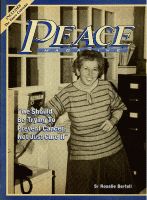
Peace Magazine May 1985, page 27. Some rights reserved.
Search for other articles by Doug Mohr here
IT IS ESTIMATED THAT NEARLY 100 million North Americans viewed the film The Day After. This film and others, such as Testament and, more recently, Threads, have brought the horror of nuclear war into the comfort of North American living rooms. As a result, these films have sensitized North Americans to the devastation of nuclear war and have made them more supportive of disarmament initiatives. (A Gallup poll in August of 1984 showed that 87% of Canadians support a multilateral freeze). Nevertheless, exposure to these films and other material on the arms race has not caused large numbers of people to become active in the peace movement.
Let me begin my explanation of why increased exposure to the horror of nuclear war has not led to increased activism by putting forward two general principles. First, individuals will consider action only if they believe that the nuclear arms race threatens their lives, or the lives of others they care for. Second, even if an individual believes that the arms race poses a serious threat, the individual will only act if he/ she believes that action will have an impact.
Implicit in the first principle is the assertion that an individual's knowledge of the horror of nuclear war is not necessarily accompanied by a belief that nuclear war is likely to occur. For example, last summer, I conducted a study involving a random sample of 74 Kitchener-Waterloo adults. Virtually all of the respondents in this study felt that they would not personally survive a nuclear war. However, most of the respondents (67~o) felt nuclear war was unlikely to occur.
You might ask how it is possible that the public thinks nuclear war is unlikely. Certainly there has been enough media coverage to convince the public that nuclear war threatens their lives. But this coverage has focussed on the disaster nuclear war would create, not on the probability that nuclear war would occur.
For example, there has been virtually no coverage of the accidental breakdowns of the computers that control nuclear weapons, and only minuscule discussion of the threat that the now very-short launch times pose, etc. such information it is understandable that the majority of the public perceives little risk of nuclear war. Obviously, then, there is a strong need for an educational campaign which will bring the perceptions of the public into line with the reality of the danger of the arms race. Rut this alone is not enough!
Since 67% of the people we sampled felt nuclear war was unlikely, 33~o of the people surveyed must have felt that nuclear war was likely to occur. But not one of these people had taken any form of action to prevent this occurrence. This is the situation addressed by the second of the two principles set out above: Even if an individual believes that the arms race poses a serious threat, the individual will act only if he/ she believes that action will have an impact. In short, individuals will only act if they feel empowered.
Of the people we surveyed, over 82% felt helpless to bring about a stop to the arms race. In contrast, a study of peace activists revealed that 70% felt that they could have an impact upon stopping the arms race. It appears that peace activists feel empowered because they are aware of the large number of people around the world that are working for peace.
If the peace movement in Canada, and elsewhere, is to become a broadly based grass roots movement, it must educate the public to see the arms race for what it is, a real and immediate threat to their existence. However, by itself, education is not enough. In fact, education alone may even be detrimental. Raising concern with regard to the arms race without empowerment leaves a person without hope.
My prescription for the peace movement then is to both educate and empower the general public.
If the peace movement is to be successful we must adopt different strategies than we have employed in the past. Up till now our major vehicle for educating the public has been to sponsor public meetings. Turnouts at public meetings are usually quite small. For example, if we have an attendance of over 100 people at a public meeting in Kitchener-Waterloo, we are ecstatic, even though an attendance of 100 people out of a population of over 260,000 is dismal.
Such a low turn-out is, however, understandable. If you believe that nuclear war is unlikely to occur, or if you feel it is likely, but feel helpless, why waste your time attending a public meeting? In short, the level of knowledge that the public presently will not bring them to us. We must go to them. Unless we are going to knock on every door in Canada, we must use mass communication to reach the general public.
One strategy that is currently being developed is to run ads on television and radio in Ontario (with plans to expand across Canada). These ads will be specially designed to educate the public about the real threat posed by the arms race, while at the same time empowering them to act. Each ad will carry with it a toll free number which members of the public can call to find out what disarmament groups are active in their area, to make donations to the peace movement, or to simply ask questions.
Regardless of what specific strategy is utilized we must take our message to the public, and that message must leave the public feeling empowered. The success of the Canadian peace movement may very well rest on our ability to accomplish this task.
Doug Mohr is a graduate student in the Psychology Department at the University of Waterloo.